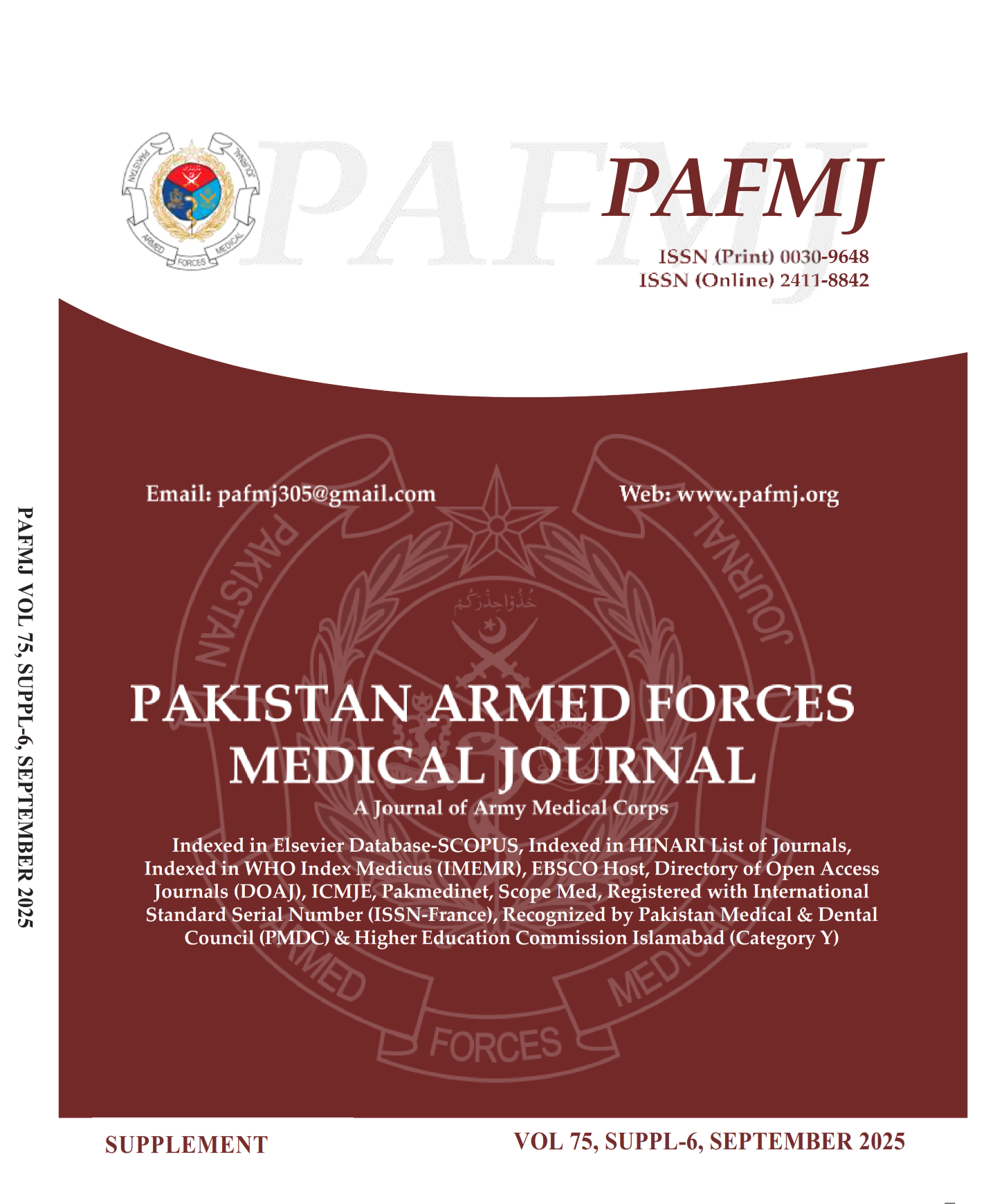Assessment of Radiological Doses to Radiation Workers in [F-18] FDG Production Facility at AFIRI Rawalpindi
DOI:
https://doi.org/10.51253/pafmj.v75iSUPPL-6.8025Keywords:
Contamination, Extremity, F-18 FDG, Ionizing Radiation, Nuclear Medicine, Occupational Exposure, Unsealed Radioactive SourcesAbstract
Objective: Present study conducted for the measurement of radiation doses received by the radiation workers due to their direct involvement in handling of unsealed radionuclides for the PET/CT scanning.
Study Design: Quasi Experimental Study.
Place and Duration of Study: PET-CT and Cyclotron Department, Armed Forces Institute of Radiology and Imaging, Rawalpindi Pakistan, from Aug 2020 to Jul 2021.
Methodology: TLD film badges and ring dosimeters, based on LiF:Mg:Ti material, were used for the detection and measurement of radioactivity. The measurements were performed for both whole body and extremity (fingers) dose measurements.
Results: The measured radiation doses were in the range of 362.75 mSv/y to 409.74 mSv/y and 0.08 mSv/y to 4.35 mSv/y for extremities and whole body, respectively. Number of injections was calculated for extremity workers and found to be 720±27 injections per worker per year.
Conclusion: The measured results clearly show that the annual doses for whole body (20 mSv/y) and extremity (500 mSv/y) of radiation workers are under the recommended limits. However, radiation workers with direct access to radioisotopes were more exposed to radiation. The results of present study were also in good correspondence with the published data.
Downloads
References
1. Rahman SU, Ahmad S, Mehdi A, Rafique M, Fatima S, et al. Measurement of extremities doses to occupational workers by using ring dosimeters. PJR 2018; 28(2): 145-149.
2. Mehdi A, Khan K, Jabbar A, Rashid A. Measurement of Gamma Emitting Radionuclides in Environmental Samples of Talagang Tehsil-District Chakwal. Nucl Sci 2017; 2(2): 54-58.
3. Mehdi SA, Rahman SU, Khan K, Jabbar A, Rafique M. Assessment of Annual Effective Dose from Measured Soil Radioactivity Levels Using HPGe Detector. Univers J Eng Sci 2016; 4(4): 79-83.
4. International Commission on Radiological Protection. ICRP Publication 103: Recommendations of the ICRP. Annals of the ICRP 2008.
5. International Atomic Energy Agency IAEA. Practical radiation technical manual, personal protective equipment. IAEA-PRTM-5. IAEA: Vienna, 2004.
6. Sarwar MR and Saqib A. Cancer Prevalence, incidence and mortality rates in Pakistan in 2012. Cogent Med 2017; 4(1): 1-13.
7. Martin CJ. Strategies for assessment of doses to the tips of fingers in nuclear medicine. J. Radiol. Prot 2016; 36(3): 405-418.
8. Dhanse S, Martin CJ, Hilditch TE and Elliott AT. A study of doses to the hands during dispensing of radiopharmaceuticals. Nucl. Med. Comm 2000; 21(6): 511-529.
9. Ivanova SD. Radiation Exposure to the Stuff Working in PET/CT and Cyclotron Facility. BgNS Trans 2016; 21(1): 63-66.
10. Wabdan AA, Yassin HM, El- Nagdy MS. Occupational Radiation Exposure to Workers Used 18-FDG. MJS 2018; 29(4): 100-105.
11. Santana PC, Oliveira PMC, Mamede M, Silveira MC, Aguiar P, Real RV, et al. Ambient radiation levels in positron emission tomography/computed tomography (PET/CT) imaging center. Radiol Bras 2015; 48(1): 21–25.
12. Wrzesień M and Napolska K. Investigation of radiation protection of medical staff performing medical diagnostic examinations by using PET/CT technique. J. Radiol. Prot 2015; 35(1): 197.
13. Li W, Fang L, and Li J. Exposure Doses to Technologists Working in 7 PET/CT Departments. DOS 2020; 18(3): 1-6.
14. Dalianis K, Kollias G, Nikaki A, Vlachou F, Efthimiadou R, Andreou J, et al. Staff Dose at Different Body Regions and at Different Stages of 18-F FDG PET/CT Procedures. Phys Med 2016; 32(3): 239-239.
15. Adliene D, Griciene B, Skovorodko K, Laurikaitiene J, Puiso J. Occupational radiation exposure of health professionals and cancer risk assessment for Lithuanian nuclear medicine workers. Environ Res 2020; 183(1): 1-10.
16. Alnaaimi M, Alkhorayef M, Omar M, Abughaith N, Aldouij M, Salhudin T, et al. Occupational Radiation Exposure in a Nuclear Medicine Department in Kuwait. Radiat Phys Chem 2017; 140(1): 233-236.
17. Alkhorayef M. Mayhoub FH. Salah H, Sulieman A, Al-Mohammed HI, Almuwannis M, et al. Assessment of occupational exposure and radiation risks in nuclear medicine departments. Radiat Phys Chem 2019; 170(1): 1-13.
18. Tulik P, Kowalska M, Golnik N, Budzynska A, Dziuk M. Measurements of the Ionizing Radiation Level at a Nuclear Medicine Facility Performing PET/CT Examinations. Radiat Prot Dosim 2016; 174(4): 501–509.
19. Jakubowska T, Długosz-Lisiecka M. Estimation of effective dose using two ICRP criteria, applied to radiation protection of personnel in an unshielded PET cyclotron facility. Radiat Phys Chem 2020; 171(1): 1-6.
20. Roberts F, Gunawardana DH, Pathmaraj K, Wallace A, Paul LU et al. Radiation Dose to PET Technologists and Strategies to Lower Occupational Exposure. J Nucl Med Technol 2005; 33(1): 44–47.
21. Emad El-din MM, Mahmoud RMM, Abaza A, Eid I, Ez El-din MR, Rizk RA. Occupational Radiation Exposure in PET/CT Units. Arab J. Nucl. Sci. Appl 2017; 50(3): 58-65.
22. Lee WJ, Choi Y, Ko S, Cha ES, Kim J et al. Projected lifetime cancer risks from occupational radiation exposure among diagnostic medical radiation workers in South Korea. BMC Cancer 2018; 18(1): 1206-1215.
Downloads
Published
Issue
Section
License
Copyright (c) 2025 Syed Ali Mehdi, Rizwan Bilal, Atiq Ur Rehman Slehria, Ali Jamal, Mudassar Ahmad, Nisar Ahmed

This work is licensed under a Creative Commons Attribution-NonCommercial 4.0 International License.















